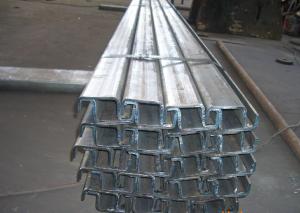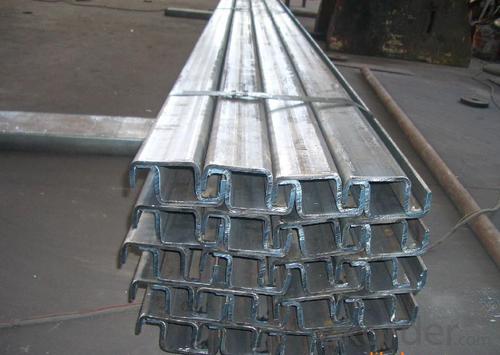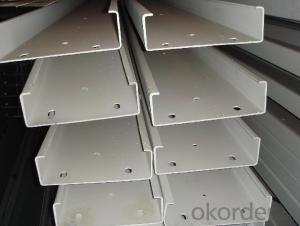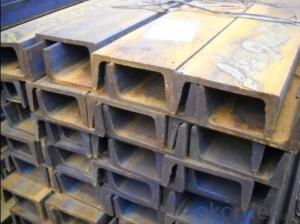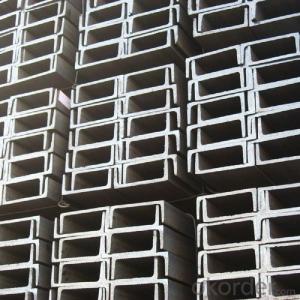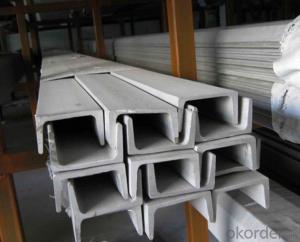MS Steel C Channel
- Loading Port:
- Tianjin Port, China
- Payment Terms:
- TT or LC
- Min Order Qty:
- 10Tons m.t.
- Supply Capability:
- 500 Tons Per Month m.t./month
OKorder Service Pledge
OKorder Financial Service
You Might Also Like
Specifications of MS Steel C Channel:
1. We are definitely speciallizing in manufacturing and supplying channel steel as per japanese standard, which is characterised with high mechanical strength and competitive prices.
2. The sections in details are as followings in the table-1
Size | Weight(kg/m) | Size | Weight(kg/m) |
80×40×20×2.5 | 3.925 | 180×60×20×3 | 8.007 |
80×40×20×3 | 4.71 | 180×70×20×2.5 | 7.065 |
100×50×20×2.5 | 4.71 | 180×70×20×3 | 8.478 |
100×50×20×3 | 5.652 | 200×50×20×2.5 | 6.673 |
120×50×20×2.5 | 5.103 | 200×50×20×3 | 8.007 |
120×50×20×3 | 6.123 | 200×60×20×2.5 | 7.065 |
120×60×20×2.5 | 5.495 | 200×60×20×3 | 8.478 |
120×60×20×3 | 6.594 | 200×70×20×2.5 | 7.458 |
120×70×20×2.5 | 5.888 | 200×70×20×3 | 8.949 |
120×70×20×3 | 7.065 | 220×60×20×2.5 | 7.4567 |
140×50×20×2.5 | 5.495 | 220×60×20×3 | 8.949 |
140×50×20×3 | 6.594 | 220×70×20×2.5 | 7.85 |
160×50×20×2.5 | 5.888 | 220×70×20×3 | 9.42 |
160×50×20×3 | 7.065 | 250×75×20×2.5 | 8.634 |
160×60×20×2.5 | 6.28 | 250×75×20×3 | 10.362 |
160×60×20×3 | 7.536 | 280×80×20×2.5 | 9.42 |
160×70×20×2.5 | 6.673 | 280×80×20×3 | 11.304 |
160×70×20×3 | 8.007 | 300×80×20×2.5 | 9.813 |
180×50×20×2.5 | 6.28 | 300×80×20×3 | 11.775 |
180×50×20×3 | 7.536 | ||
180×60×20×2.5 | 6.673 |
Table-1
3. The mechanical property of MS Steel C Channel in the table-2:
Grade | Yield Strength,N/mm² | Extension Strength N/mm² | |||
Thickness of Steel,mm | |||||
≦16 | >16-≦40 | >40-≦100 | >100 | ||
SS330 | ≧205 | ≧195 | ≧175 | ≧165 | 330-430 |
SS400 | ≧245 | ≧235 | ≧215 | ≧205 | 400-510 |
SS490 | ≧285 | ≧275 | ≧255 | ≧245 | 490-610 |
SS540 | ≧400 | ≧390 | - | - | ≧540 |
Table-2
4. The chemical composition of MS Steel C Channel in the table-3
Grade | Element(%) | |||
C | Mn | P | S | |
SS330 | -- | -- | ≦0.050 | ≦0.050 |
SS400 | ||||
SS490 | ||||
SS540 | ≦0.30 | ≦1.60 | ≦0.040 | ≦0.040 |
Table-3
Usage of MS Steel C Channel:
1.The MS Steel C Channel can be devided into two kinds, namely common channel steel and light channel steel. The sizes of hot rolled common channel steel range from 5# to 40#. Meanwhile, the channel steel can be divided into cold forming sectional equal channel steel, cold forming sectional unequal channel steel, cold forming inner edge channel steel and outer edge channel steel.
2.The MS Steel C Channel is usually used for arch-itechtural structure, and they could be welded in order to support or hang a vari-ety of facilities. They are also usually used in combination with I beam. The channel steel with sizes under 14# is usually applied to construction engineering, as purline, while the channel steel with sizes above 16# is more likely to be used in building vehicle chassis structure and mechanical structure. Furthermore, the channel steel in sizes above 30# are target at building bridge structure, as tension bar.
3.In a word, the channel steel must possess perfect welding property, riveting property and mechanical property and so on.
Package & Delivery of MS Steel C Channel:
1.The MS Steel C Channel will be packed in bundle with steel wire at each end of every bundle and color marking in order to help the customer to recognize his goods more easily at sight.
2. And the MS Steel C Channel could be loaded into 20ft or 40ft container, or by bulk cargo.If the weight of each bundle reaches more than 3.5 mt, the loading by break bulk cargo should be choosed.When the weight of each bundle reaches less than 3mt, the loading by container should be choosed.
3.As for the transportaion from mill to loading port, the truck will be usually used. And the maximum quantity for each truck is 40mt.
4.All in all, we could do in accordance with customer's request.
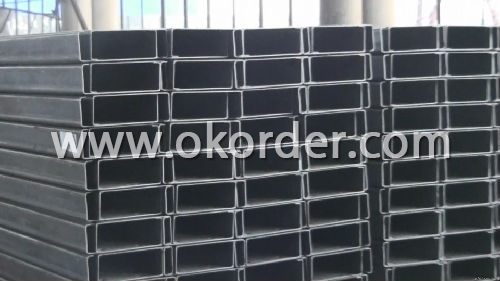
Production Flow of MS Steel C Channel:
1.The steel billet shall be heated in the high temperature furnace.
2. The heated steel billet shall be rolled five to nine times with the aim of shaping the general figure of steel u channel.
3. The rolled steel channel should be put onto the cooling bed to make the temperature low.
4. The MS Steel C Channel should be straighted on the straightener.
5. The straighted steel u channel will be cut into meters by saw, as per customer's requirements.
6. At the last part of production, the channel steel must be tested in order to confirm that the finished products are completely free from crack, pore, slag, scab or fold on the surface.
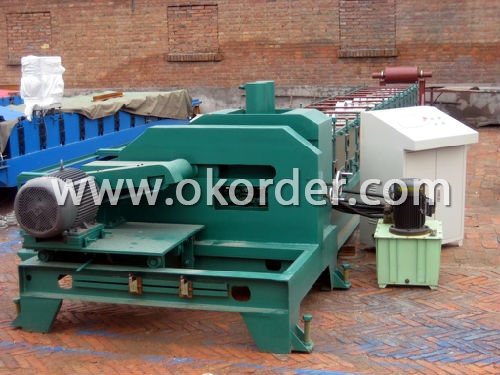
- Q: What is the purpose of steel channels?
- Steel channels serve a variety of purposes in various industries and construction projects. The primary purpose of steel channels is to provide structural support and enhance the stability of a structure. They are commonly used in the construction of buildings, bridges, and other infrastructure projects. Steel channels are designed to distribute the weight and load of a structure, ensuring that it can withstand the forces it may be subjected to. They are often used as beams or columns, providing strength and rigidity to the overall framework. Additionally, steel channels can be used as bracing elements to prevent lateral movements and increase the stability of a structure. Another purpose of steel channels is to facilitate the installation of electrical wiring, plumbing, and HVAC systems. Channels can be integrated into walls or ceilings, allowing for the concealed installation of these essential utilities. This not only provides a clean and organized appearance but also ensures the safety and longevity of the building's infrastructure. Moreover, steel channels are commonly used in the manufacturing and industrial sectors. They can be utilized to create conveyor systems, support equipment, and machinery. The durability and strength of steel channels make them ideal for withstanding heavy loads and harsh working environments. Overall, the purpose of steel channels is to provide structural support, enhance stability, and facilitate the installation of utilities and equipment. Their versatility, strength, and durability make them a preferred choice for a wide range of construction and industrial applications.
- Q: What are the different types of fasteners used for steel channels?
- Steel channels can be fastened using a variety of fasteners. 1. Fasteners like bolts offer a common and reliable option. They come in different sizes and materials, such as stainless steel, carbon steel, and galvanized steel. Bolts typically have a threaded shank and can be secured with a flat head or a nut. 2. Another popular choice is screws, which have a threaded body and a pointed tip. Self-tapping screws are often used with steel channels as they can create their own threads without the need for pre-drilling. 3. Nuts and washers can be used in combination with bolts to enhance stability and prevent loosening over time. Nuts are threaded and can be tightened onto the bolt, while washers distribute the load and protect the channel's surface. 4. Rivets are permanent fasteners commonly used for joining steel channels. They consist of a cylindrical shank with a head on one end and a tail on the other. The tail is inserted through pre-drilled holes and then deformed to create a secure connection. 5. Welding is a specialized method that involves melting the edges of steel channels together to create a strong and permanent connection. It is often used in structural applications that require high strength and rigidity. These examples showcase the various types of fasteners available for steel channels. The selection of the appropriate fastener depends on factors like load requirements, channel type, desired permanence, and available tools. Consulting with professionals is crucial to ensure the right fastener is chosen for each specific application.
- Q: Can steel channels be galvanized or coated?
- Yes, steel channels can be galvanized or coated. Galvanizing involves applying a protective zinc coating to the surface of the steel channel, while coating can refer to various other types of protective coatings such as paint or powder coating. Both galvanizing and coating help to prevent corrosion and extend the lifespan of the steel channel.
- Q: Can steel channels be used in load-bearing applications?
- Absolutely, load-bearing applications can certainly make use of steel channels. In construction and engineering undertakings, steel channels find frequent employment due to their commendable robustness and durability. Their purpose is to furnish structural reinforcement and ensure uniform weight distribution. Steel channels possess the capacity to endure substantial loads and exhibit remarkable resistance against bending and torsional stresses. Moreover, they lend themselves effortlessly to customization and adaptation, rendering them well-suited for an array of load-bearing applications encompassing bridges, edifices, heavy machinery, and infrastructure projects.
- Q: What are the different testing methods for steel channels?
- There are several testing methods for steel channels, including visual inspection, dimensional measurement, ultrasonic testing, magnetic particle testing, and load testing. Visual inspection involves examining the surface of the channel for any visible defects or irregularities. Dimensional measurement ensures that the channel meets the specified dimensions. Ultrasonic testing uses high-frequency sound waves to detect internal defects such as cracks or voids. Magnetic particle testing utilizes magnetic fields and iron particles to identify surface cracks or discontinuities. Load testing involves applying a known load to the channel to evaluate its strength and deformation characteristics.
- Q: How do steel channels perform in high-vibration environments?
- Steel channels are known for their excellent strength and durability, making them suitable for various applications, including high-vibration environments. In such environments, steel channels perform exceptionally well due to their inherent properties. Firstly, steel channels have a high tensile strength, allowing them to withstand significant vibration forces without deforming or breaking. This strength is crucial in high-vibration environments where constant motion and mechanical stress are present. The robust nature of steel channels ensures their ability to handle the vibrations effectively. Moreover, steel channels have excellent damping characteristics, meaning they can absorb and dissipate energy from vibrations. This property helps to minimize the impact of vibrations on the overall structure or equipment. By reducing the amplitude of the vibrations, steel channels contribute to maintaining stability and preventing potential damage or failures. Additionally, steel channels can be designed and manufactured to meet specific requirements, allowing for customization based on the intensity and frequency of the vibrations. This flexibility in design enables engineers to select appropriate dimensions, cross-sections, and configurations to optimize the performance of steel channels in high-vibration environments. Furthermore, steel channels are highly resistant to corrosion, which is particularly important in environments where moisture, chemicals, or other corrosive agents may be present. Corrosion can weaken the structural integrity of any material, but steel channels are able to retain their strength and performance over extended periods, even in harsh conditions. In summary, steel channels are well-suited for high-vibration environments due to their high tensile strength, excellent damping characteristics, design flexibility, and corrosion resistance. These qualities make steel channels a reliable and efficient choice for applications in industries such as construction, infrastructure, transportation, and manufacturing, where high-vibration environments are common.
- Q: What are the standard lengths of steel channels?
- Different industries and manufacturers establish their own requirements and standards, leading to variations in the standard lengths of steel channels. However, there are commonly used standard lengths for steel channels, typically available in increments of 6 or 12 feet (1.83 or 3.66 meters). These standard lengths find widespread use in construction, manufacturing, and other sectors. Steel channels are commonly found in lengths of 20 feet (6.1 meters), 40 feet (12.2 meters), and 60 feet (18.3 meters), which are convenient for transportation, handling, and utilization in structural or fabrication projects. It is worth noting that although these are frequently encountered standard lengths, steel channels can also be custom-cut to meet the specific requirements of a given project. Additionally, regional or industry-specific standards may introduce variations in standard lengths. To obtain more precise information regarding the standard lengths of steel channels for a particular application, it is advisable to consult relevant industry standards, such as those established by organizations like the American Society for Testing and Materials (ASTM) or the American Institute of Steel Construction (AISC).
- Q: Are steel channels suitable for modular construction practices?
- Yes, steel channels are suitable for modular construction practices. Steel channels are commonly used in modular construction due to their versatility, strength, and ease of installation. They provide structural support and can be easily assembled and disassembled, making them ideal for modular construction where flexibility and efficiency are key.
- Q: Can steel channels be customized according to specific requirements?
- Indeed, specific requirements can be accommodated through the customization of steel channels. In the construction and manufacturing industries, steel channels find widespread use for framing, support, and reinforcement purposes. These channels can be tailored to meet precise project specifications in terms of size, shape, length, thickness, and material composition. By customizing steel channels, a higher degree of flexibility and adaptability can be achieved in diverse applications. For example, the channel's dimensions and form can be modified to align with specific structural designs or to withstand particular loads and stresses. The channel's length can be personalized to suit the project's dimensions, while the thickness can be adjusted to provide the desired strength and durability. Moreover, material composition is another aspect that can be customized for steel channels. Depending on the project's requirements, various steel types, including carbon steel, stainless steel, or alloy steel, can be employed. This customization ensures that the steel channel possesses the necessary properties, such as corrosion resistance, heat resistance, or high tensile strength, to successfully endure the intended application. In summary, steel channels can undoubtedly be customized to cater to specific requirements, offering a versatile solution for a wide range of construction and manufacturing needs.
- Q: What are the different methods of protecting steel channels from weathering?
- To prevent weathering and extend the lifespan of steel channels, there are multiple methods to choose from. These methods aim to combat corrosion and safeguard the integrity of the channels. The following are some commonly used techniques: 1. Coatings: Applying protective coatings is highly effective in preventing weathering on steel channels. These coatings can come in the form of paint, epoxy, or zinc-based materials. By acting as a barrier, the coating stops moisture and oxygen from reaching the steel surface and causing corrosion. 2. Galvanization: Galvanizing steel channels involves coating them with a layer of zinc. This method provides exceptional protection against weathering as the zinc acts as a sacrificial anode, corroding instead of the steel. Galvanized steel channels exhibit enhanced corrosion resistance and can withstand harsh weather conditions. 3. Powder coating: Powder coating is a popular technique for shielding steel channels from weathering. It entails applying a dry powder to the channels' surface, which is then heated and cured to form a durable protective layer. Powder coating not only provides a decorative finish but also offers excellent resistance to corrosion, UV rays, and weathering. 4. Stainless steel: Utilizing stainless steel channels is another effective means of weathering protection. Stainless steel contains chromium, which forms a passive oxide layer on the surface, safeguarding it from corrosion. Stainless steel channels exhibit high resistance to rust, making them suitable for outdoor applications. 5. Design considerations: Proper design and engineering can also play a crucial role in protecting steel channels from weathering. This involves incorporating drainage systems to prevent water accumulation, ensuring adequate ventilation to minimize moisture buildup, and avoiding the use of dissimilar metals that could trigger galvanic corrosion. In conclusion, several methods are available for protecting steel channels from weathering. Each method offers varying levels of protection, and the choice depends on factors such as the environment, budget, and desired lifespan of the steel channels. Selecting the appropriate method is crucial to ensure the durability and performance of steel channels in outdoor applications.
1. Manufacturer Overview
| Location | Tianjin, China |
| Year Established | 2007 |
| Annual Output Value | Above US$ 15 Million |
| Main Markets | Southeast Asia; Africa |
| Company Certifications |
2. Manufacturer Certificates
| a) Certification Name | |
| Range | |
| Reference | |
| Validity Period |
3. Manufacturer Capability
| a) Trade Capacity | |
| Nearest Port | Tianjin |
| Export Percentage | 15%-20% |
| No.of Employees in Trade Department | 11-20 People |
| Language Spoken: | English; Chinese; |
| b) Factory Information | |
| Factory Size: | Above 6,500 square meters |
| No. of Production Lines | 1 |
| Contract Manufacturing | OEM service offered |
| Product Price Range | average |
Send your message to us
MS Steel C Channel
- Loading Port:
- Tianjin Port, China
- Payment Terms:
- TT or LC
- Min Order Qty:
- 10Tons m.t.
- Supply Capability:
- 500 Tons Per Month m.t./month
OKorder Service Pledge
OKorder Financial Service
Similar products
Hot products
Hot Searches
Related keywords
